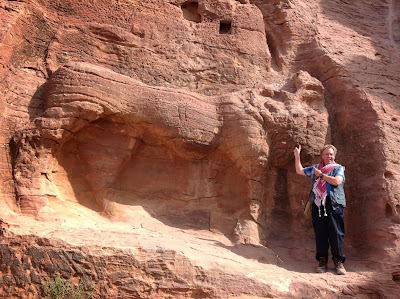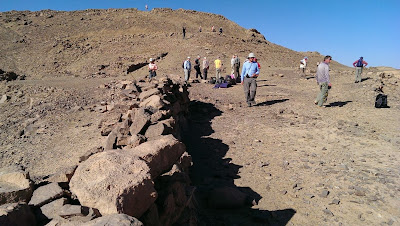The sun was rising as we left this morning for the long trip to Mudawarra. Unusually the clouds were fairly thick, but shafts of early morning sunlight broke through to illuminate the desert landscape.
We were working for the last time in the field this season, continuing to excavate the features on the southern hilltop redoubt. You may be able to get a feel for the scale of this from some of the images. Climbing to each of the levels was extremely hazardous due to the loose gravelly sand that covered every surface, scattered between a multitude of sharp rocks, also apt to slip and slide when touched.
Whilst some of us were working on the top level, a happy, friendly young Bedouin boy clambered up the steep western side of the redoubt and presented us with this - an Ottoman grenade. Fortunately the explosive and fuse had long gone so it was completely safe. You can see the obvious Turkish crescent symbol on the surface of it.
The western side of the upper level of the redoubt is a really well constructed stone wall, with loopholes approximately every 6-10 feet sited along it. Detecting and excavating along this wall produce large numbers of Mauser cartridge finds. One of the locations proved to have 22 such cartridges in one hole.
These finds clearly indicate a used, directional firing position to the east. On the west side there were contrasting finds. A row of 303 cartridge cases were found here and indicate that the Arab/British forces at some point, perhaps even directly after taking the redoubt, fired in that direction, which is towards the station buildings. These were defended by the Ottomans with a mounted machine gun, and it looks like we may also have found evidence of incoming fire from exactly such a weapon at today's site also.
Our last day in the field has produced some really useful evidence which will help us to confirm and build upon ideas and theories concerning the attacks on this set of three redoubts.
We drove back from the fieldwork for the final time this season, really tired from the heat and the digging. The bus was virtually silent as we made our way north through mile after mile of featureless desert, past the occasional small industrial site or highway police station, until we reached the main town in this region - Ma'an. To finish today's blog, here are a few pictures taking from the moving bus, of Ma'an as we travelled through it. Tomorrow is our final day, and we are all doing different things. There will be a blog with a selection of images taken by the team this year.




.jpg)
.jpg)






















































